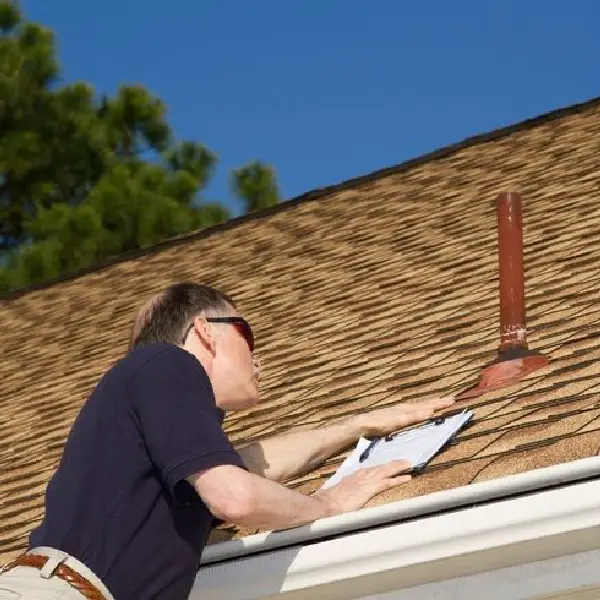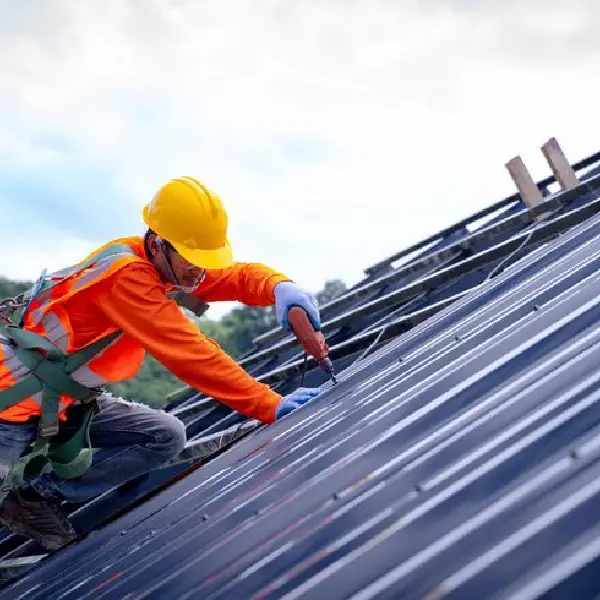Roof Inspection Ultimate Guide: Everything You Should Know

Beyond only providing protection, the roof over your head functions as a whole system.
Together with protecting the rest of your home from the elements and rain, your roof also lets in air and keeps wind and snow out.
Such are heavy tasks, all carried out by your roof in the open air. By getting a home roof inspection as necessary, you can take care of your roof. Any queries you have about roof inspections will be addressed by this guide.
What Is a Roof Inspection?
A comprehensive assessment of all roofing elements within or on top of your house is called a roof inspection.
The system on your roof is mechanical. It could appear to be a non-functional aspect of your home.
However, your roof serves a similar purpose as the plumbing, electrical, and HVAC systems in your house. It needs to be properly maintained and inspected on a regular basis to guarantee dependable service.
The purpose of the inspection is to assess how well your roof is functioning right now and what, if anything, needs to be done to fix any issues.
What's Included in a Roof Inspection?
Every item on a roof, including its structural support, the stability of the roofing material, and any indications of damage to the walls or ceiling, will be inspected by a roof inspector using a checklist.
Inspection of Structures
The structural examination will evaluate the overall stability of the roof system. In this section of the inspection, it is necessary to search for any indications that, given the arrangement of the roof planes, may indicate a drooping roof.
The primary goal of a structural examination is to assess the overall health of the roofing system, rather than to locate missing or damaged roofing components. A sinking roof may exhibit the following signs:
- Rotten, broken, or cracked rafters or trusses
- Sagging ceilings
- Broken or absent collar ties
- Broken or absent rafter ties
- Outside walls that are skewed or leaned
The inspector will examine your gutters, fascia, and soffit while they are up on the roof.
They will look for any indications of damage to any skylights, chimneys, or vents you may have by inspecting the outside, grout, and seals.
Materials inspection
The roofing materials, such as shingles, metal plates, clay, or even slate shingles, will be the subject of the material section of the roof inspection.
The inspector will look them over for any damage, missing parts, rust, moss, or water damage stains.
Checking for leaks, fractures, or pests on the flashing beneath the roofing material is another aspect of the material inspection.
Interior inspection
Any indications of roof damage that are hidden from view from the exterior will be examined during the interior phase of the inspection.
The interior walls, attics, and ceilings of the house will all be inspected by inspectors. Usually, the following will be displayed on the signs:
- Stains from water
- Wood decay
- Mold
- Holes in the ceiling or walls
- Light beams from the ceiling into the attic
- Vermin in the loft
A Checklist for Roof Inspector
To make sure that every part of the roof is evaluated completely and regularly, a roof inspection checklist might be helpful.
Early detection of any possible issues may also be beneficial since it can prevent them from getting worse and being more expensive to fix.
Surface Materials
When inspecting roofing materials, inspectors look for damage indicators including broken seams, rust, and corrosion on metal roofs; chips and cracks in slate and tiles; and missing granules, curling, and cracks in shingles.
They also search for indications of algae or moss growth and water damage.
Decking and Frame
Inspection of the decking and frame roof is crucial to preserving a building's structural integrity.
In this kind of examination, the roof decking and framework are examined to make sure they are in excellent condition and strong enough to withstand the weight of the roof and any additional loads.
A trained inspector will search for evidence of damage, rot, decay, or other problems that can jeopardize the integrity of the roof during a decking and frame roof inspection.
They will also look for any possible safety risks, correct installation, and sufficient ventilation.
Roof Penetrations
Roof penetrations are holes in the roof that let you attach different kinds of parts, such as vents, skylights, and chimneys.

image sourced from here
These penetrations are closely inspected for evidence of wear or deterioration that might cause leaks during a roof inspection.
Typical indications of damage to roof penetrations consist of corrosion, fractures, and broken or absent flashing.
In addition, the inspector will look for any indications of interior water damage, such as stains on the walls or ceiling.
Fascia and Soffits
Essential parts of a roof system that ventilate and shield the roof from the weather are fascia and soffits.
It's essential to do a comprehensive check of these components to guarantee the roof's lifespan and integrity.
Examining fascia and soffits for deterioration indicators like rot, holes, or cracks is part of the inspection process.
It also entails making sure they are firmly fixed to the walls and roof and verifying that the installation was done correctly.
The inspector will also search for indications of insect infestation or moisture intrusion.
Visible damage, peeling or cracking paint, drooping or loose boards, and indications of water damage or mold development are common warning signs that suggest the need for fascia and soffit repair or replacement.
Frequent inspections can aid in the early detection of these problems, halting additional harm to the roofing system.
Attic
A thorough assessment of the state and health of your attic is done during an attic inspection.
It entails looking for concerns such as structural deterioration, inadequate ventilation, inadequate insulation, and moisture issues.
An expert will usually evaluate your attic's insulation, ventilation, and general structural soundness during an examination. In addition, they'll search for indications of dampness, vermin, and other possible issues.
Ventilation System
An extensive analysis of a home's ventilation system to make sure it is operating correctly and supplying enough airflow is known as a ventilation inspection.
It entails inspecting a number of parts, such as air filters, fans, ducts, and vents. A well-operating ventilation system is essential for eliminating pollutants, minimizing moisture accumulation, and preserving acceptable indoor air quality.
Gutter System
An essential maintenance chore is inspecting the gutters, downspouts, and other parts of the roof drainage system.
This is known as a gutter system roof inspection. By doing this examination, you can be confident that the gutters are clear of debris, securely fastened to the roof, and operating as intended to keep the structure from being flooded.
An expert inspector looking to evaluate a gutter system roof will search for deterioration indicators including rust, corrosion, leaks, drooping, or blockages.
They will also make sure that water is appropriately channeled away from the structure by inspecting the gutter and downspout alignment.
How Often Should You Schedule a Roof Inspection?
Having your roof examined is advised at least once a year, preferably in the spring and fall.
This will assist in spotting any possible issues early on, before they worsen and become more expensive to fix.
In case your roof is above fifteen years old, you might want to think about getting it examined more often, like once every six months. This is due to the increased likelihood of issues with older roofs.
Roof Inspections Cost
Roofing inspections typically run about $225. However, the cost might vary from $75 to $900 based on the kind of roofing material, the form of your roof, and the depth of the examination.
Be cautious even if some contractors provide a free roof check. You don't want to be the victim of expensive or needless roof repairs.
Examining the Roof Physically
An individual must scale the roof in order to conduct a physical roof inspection. This kind of roof inspection is the most basic and primarily visual. The typical price range for a physical roof inspection is $75 to $200.
Unmanned Aerial Vehicle Inspection
When climbing onto a roof poses too much risk, homeowners have the option to request a drone assessment of their roof.

image sourced from here
When a roof is extremely steep or impassable, this kind of assessment usually takes place.
Taking images or movies, the drone flies around the house's exterior. An assessment of a drone roof should cost between $150 and $400.
Roof Inspection Using Infrared
Compared to standard roof inspections, infrared roof inspections are more expensive.
Professional inspectors use infrared equipment to search for damage indicators, such as tiny leaks and cracks that are otherwise undetectable to the human eye. An infrared roof check will often set you back between $400 and $600.
What to Do After Receiving the Roof Inspection Report?
Here is what you should do after receiving the roof inspection report. Examining an inspection report's findings closely is the first thing to do after getting it.
The report should include information on the precise problems found, where they are, and how serious they are.
But the question is: What problems and issues must be repaired in the house?
Roof Repairs and Replacement
Roof repair is the process of addressing individual problems, such as leaks, chipped shingles, or little structural damage, without having to replace the entire roof.
It is perfect for taking care of urgent issues and offering makeshift fixes for unforeseen issues.
In the cases we have mentioned below, you have to repair or replace the roof:
- Damaged shingles
- Clogged gutter
- Poor maintenance
- Damaged flushing
- Ventilation
- Water damage
- Roof leaks
- Storm damage
- Aged roofs
FAQs
How do I know if my roof needs replacing?
Your roof might need to be replaced if:
- It is 20 to 30 years old
- You see evidence of evidence of clawing, curling, cupping, mildew, or rotten tiles
- You see any missing, slid, damaged, or curled tiles
- You notice sagging or drooping
- You see moisture buildup and additional harm to your house
How long does a roof inspection take?
While most roof inspections take 45 to 60 minutes, a thorough evaluation of some roofs may take up to four hours. It's possible that a roofer you engage for a 15-minute check will overlook damage indicators.
Will my insurance cover roof damage?
Generally speaking, storm, fire, and vandalism-related roof damage is covered by most home insurance plans.
Damage deemed to be the consequence of regular wear and tear or neglect, however, might not be covered.
What is the difference between a roof inspection and a home inspection?
A home inspector looks at every aspect of the property, such as the HVAC, plumbing, electrical, and foundation systems.
On the other hand, roof inspectors just look at the roof; its components, flashing, and drainage system included.
How can I prevent roof damage?
Regularly checking your roof for wear and tear indicators, such as missing or broken shingles, leaks, or drooping sections, is one strategy to prevent roof damage. Additionally, keeping your gutters clear of dirt and clean will assist shield your roof from water damage.
Conclusion
Home roof inspection is something you are recommended to do every 2 years, according to prevent serious roof damage.
If you are wondering how to get the roof inspection done by yourself, read this article to find out about its checklist.
Besides, we have mentioned important tips and topics about roof home inspection, such as costs and the items included in a home roof inspection.
- In this post:
- What Is a Roof Inspection?
- What's Included in a Roof Inspection?
- A Checklist for Roof Inspector
- How Often Should You Schedule a Roof Inspection?
- Roof Inspections Cost
- What to Do After Receiving the Roof Inspection Report?
- FAQs
- Conclusion



